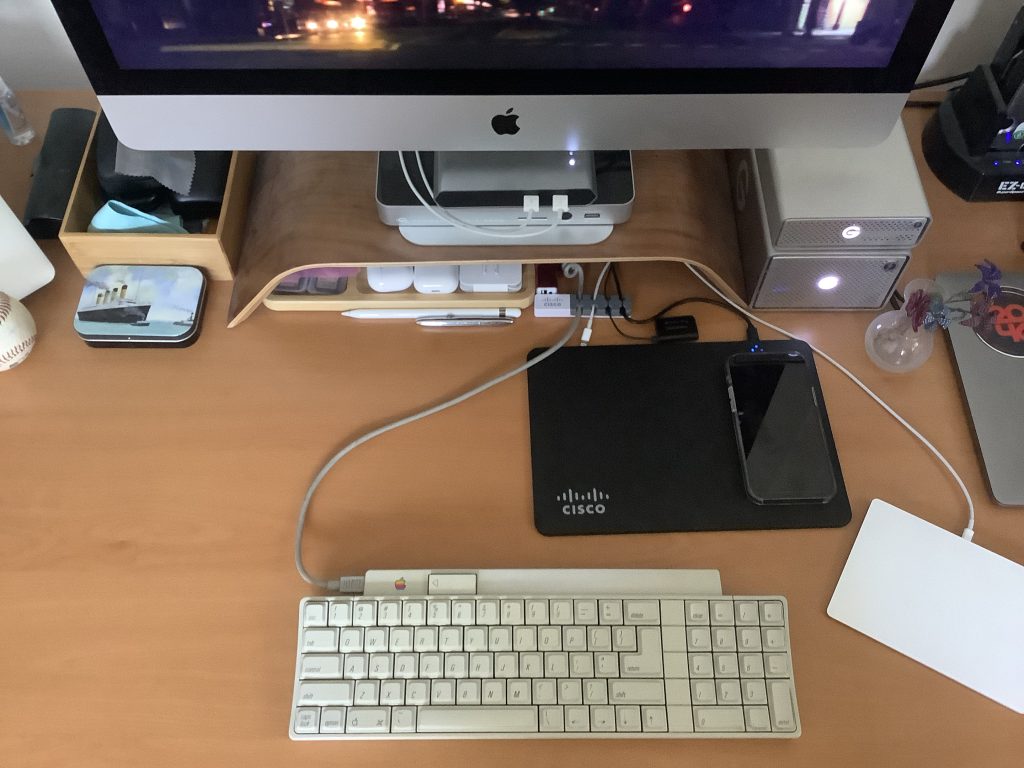I’ve been sitting at a computer, everyday, in one form or another for several decades now. Naturally I have become selective when it comes to keyboards. For example, to aid motor memory, I try to limit changing keyboards as much as possible. I use an Apple Magic Keyboard for my personal iMac, not for any specific feature, but to maintain a similar layout and feel to the built-in keyboard of my work issued MacBook Pro1.
But when push comes to shove, I have a strong affinity for mechanical keyboards. In fact, for my office desk, I have an IBM Model M2. Alas, pandemic work from home means I haven’t even set eyes on it in over a year now.
Using a Model M is any easy choice. It’s the de facto standard for keyboards. Millions of them were built and since they are rugged and long lasting, one can easily locate and buy a ready to use unit for less than a $100. Plus, PS/2 to USB adaptors are a dime a dozen.
But what about mechanical Apple keyboards? Probably my all-time favorite keyboard would be the first Apple Desktop Bus (ADB) Keyboard built for the Apple IIgs. Why? First, several Apple keyboards in the mid-80s used the Alps SKCM switches, considered by some as the best keyboard switches ever produced. Similarly, Apple introduced the Snow White design language in the mid-80s, which gives this keyboard a recognizably classic Apple look. In terms of layout, the keyboard is one of only a few Apple models I know that places the Control key next to the left pinky and pushes the Caps Lock key out of the way, to the lower left. Unlike the IIc version of the same keyboard, which was incorporated into the computer case, the external IIgs keyboard includes a number pad. Unfortunately, the overall compact design means no inverted T arrow keys or function keys.
Yet, I never considered using a classic external Apple keyboard. Unlike PS/2 to USB adaptors, ADB adaptors are harder to source. And say nothing of the pre-ADB Mac keyboards that used a 4P4C connector. But this being the Age of the Internet, I decided to source3 an adapter and put my favorite Apple keyboard to work.

As for mice, I have no nostalgia for mechanical mice. Unless we’re talking trackballs, modern optical and multitouch touchpads are far superior to the awkward and clunky mice of yesteryear.
I mentioned numerous reasons why the IBM Model M is the computer keyboard to measure against. My personal anecdote relates to the company my mother worked at, starting in the late 1980s. While the company transitioned from terminals to PCs, the back-office infrastructure remained on a mainframe. In other words, while employees got a PC that gave them a word processor and eventually email, they still had to use a virtual terminal to the company mainframe to preform core business functions. By the 2000s, the company’s offices were littered with PCs from Dell and while the Dell USB keyboard are serviceable, it was always a simple matter to identify the senior individuals at any office based on if they had a Model M keyboard instead of the standard issue Dell keyboard.
Why? Because those IBM Model M keyboards that once connected to a terminal had custom keycaps that mapped to shortcuts still in use in the back-office software.
And while the current Model M Keybaord I own wasn’t pulled from the this company, there was a time when I did have one of their discarded IBM mainframe terminals. I’ve never had a chance to do anything with it, but thankfully, the Internet is full of creative people, Connecting a Real IBM 3270 Terminal to an Emulated Mainframe.

I think many of these compact keyboards Apple built in the 80s would make great looking wireless keyboards.
1 Yes, similarly to Apple, I’m in denial about the whole butterfly keyboard fiasco
2 Take that butterfly keyboard